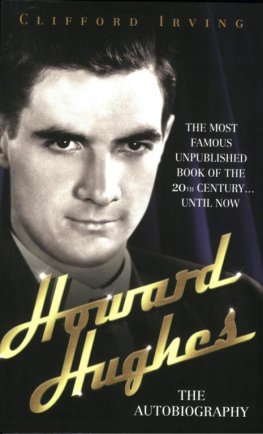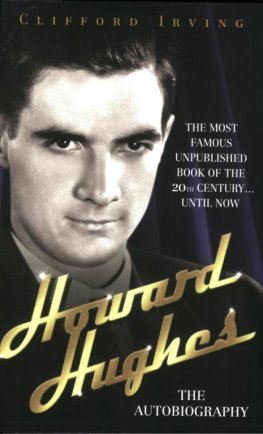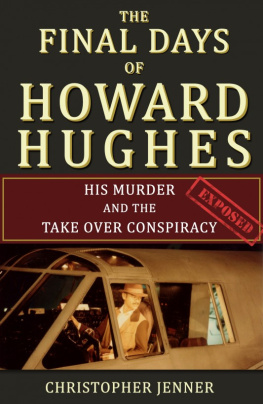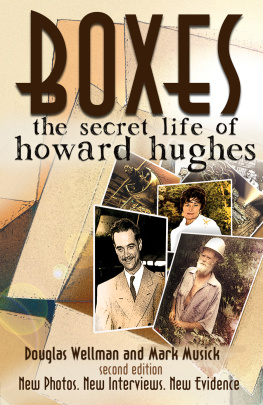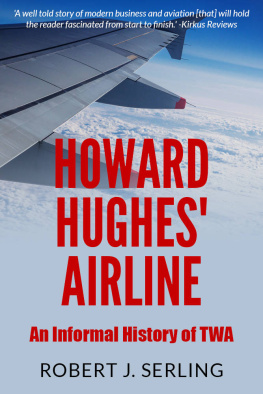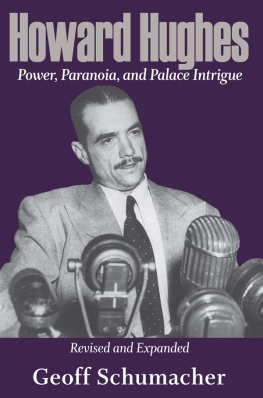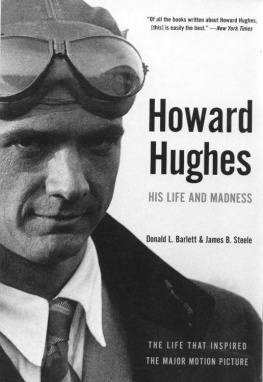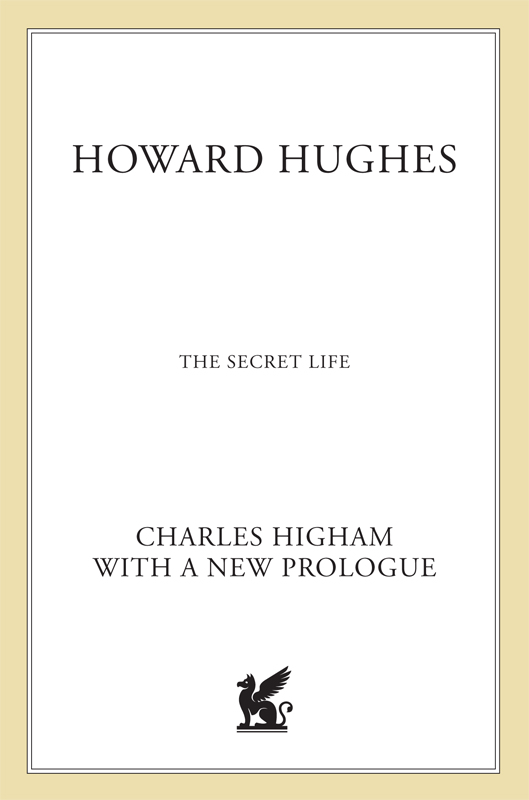
The author and publisher have provided this e-book to you for your personal use only. You may not make this e-book publicly available in any way. Copyright infringement is against the law. If you believe the copy of this e-book you are reading infringes on the authors copyright, please notify the publisher at: us.macmillanusa.com/piracy.
Contents
This book is dedicated to Richard V. Palafox and Dorris Halsey
Prologue
To the 2004 Edition
This 1993 biography came in, like Howard Hughes on any one of his hastily organized aerial adventures, by the seat of its pants. Starting in 1990, I embarked on a dark, two-year journey into Howard Hughess life, finding extraordinary and unstinting cooperation from his colleagues and friends at every level. Even his Mormon bodyguards had a few things to say, off the record. After twenty-four months of research, I wrote the book at fever pitch, delivering it in eight months. It received an enthusiastic response from national critics; even the famously hard-to-please Kirkus Reviews called it a hypnotic portrait. It became a bestseller.
Not surprisingly, as reviews and sales piled up, there were offers for the film rights. John Malkovich was determined to star as Hughes and to direct the film as well. His partner in Hollywood, Russ Smith, called my then agent to make an offer for those rights.
This was interesting: Malkovich could certainly play the gaunt, tortured, haunted older Hughes but whether he could manage to act the dashing young airman who flew around the world in three and a half days in 1938, and bedded half the female stars of Hollywood, was another matter. I guessed that the story he would approve would emphasize Hughess eccentricity and hypochondria, and the monster he could at times be.
At several pleasant lunches Russ Smith and I discussed writers of the screenplay; I didnt propose myself. I said I felt that in the last analysis only an American writer could completely understand Howard Hughes.
Russ smiled and said, Youre English and you understood him, didnt you?
As it turned out, he did hire a British writer, the up-and-coming young dramatist Terry Johnson, who would later enjoy great success as adapter of The Graduate for Broadway and London.
Terry came to Los Angeles to research the background. I liked him at once. The British usually seemed uncomfortable with their own or anyone elses success but Terry was a member of a new London breed: the upwardly and unabashedly mobile. His idea of framing the picture in reminiscences of the aged scarecrow Hughes seemed to me a sensible one.
The honeymoon with Malkovich and Smith was soon over, however. Underneath his charm, I felt in Terry a steely will, and both Malkovich and Smith were made of even sterner stuff. Draft after draft of a screenplay they would never let me see failed to satisfy them and, after an explosive quarrel, they parted company with Terry. The option was dropped.
There was talk of other versions, none of which involved my book. Warren Beatty had for years wanted to play Hughes, and direct the film biography; he had hired Bo Goldman to write a screenplay. Though the name of Stephen Spielberg was bandied about as director, the project languished again. Brian De Palma, an interesting choice, with his emphasis on the manic, was also toutedhe would possibly make a version for Keystone with a script by David Koepp.
At Universal, the Hughes brothers were developing something; Terry Hayes was to write the script with Johnny Depp as star. Charlie Evans Junior, nephew of Robert Evans, at Acapella Productions was interested in developing the story. He was a longterm Hughes addict and had collected memorabilia. I thought, there goes my book.
Then, out of the blue, I received a message from my former agent. Could I please call him at once? That seemed odd; that agent and I had parted company some time before. When I got through to him he said that he would like to come back on board, just once, for a single deal. I had no agent at the time; I was involved in the world of stage, where there were few percentages. I said I would listen.
He told me he had received calls from CAA, the big Hollywood Agency. With the heavyweight competitionseemingly half of Hollywood was making Hughes dealsmy main concern was to sign a contract immediately. He wanted to haggle over who would play Hughes.
Days went by with no word. No deal had been set. I fired my agent again.
I called Bob Bookman of CAA, whom I knew slightly from my years as a New York Times Hollywood feature writer, to see what was going on. He told me the director Michael Mann wanted my property. That was good news. I made the deal with Manns Forward Pass Productions with the help of my lawyer, Michael Harris.
Mann, I thought, with his powerful, driving, obsessive style, and his flair for melodrama, would be perfect for the job. Starting with Miami Vice, his high-octane television series, he had a flair for portraying overdriven, dark, consuming personalities. One of Hollywoods few auteurs, he had a style that was unmistakably his.
The fact that Mann had bought my book brought me untold publicity in New York. Evander Holyfield, boxing champion, had a guest column in the New York Daily News; in which he mentioned the film. Richard Johnson of the New York Post s page six ran an equally helpful item, taking up most of his column.
Leonardo DiCaprio was named as Hughes. I thought he was an ideal choice: his performance in Titanic as a young Irish immigrant, overflowing with excitement at the thought of finding a new world, showed an uncanny sense of periodhe was a lad of 1912. And underlying all of his performances was that sense of danger, of tension, that all great stars have, and that would be ideal for his portrayal of Hughes.
I was pleased to learn that John Logan was writing the screenplay; in Gladiator, he would show his capacity for portraying obsession in a Roman warriors drive for revenge of the death of his nearest and dearest. With Michael Mann on board, I could ask for no better team.
Then, suddenly, Michael Mann dropped out, at the same time as the other Hughes projects evaporated. Manns dynamic Ali, the life of Mohammed Ali, had left him not wanting to make another biography; once again, I saw the ground opening up under my feet. But then, I hit the jackpot: Mann would co-produce; so would Charlie Evans; Martin Scorsese would direct.
I had met Martin Scorsese only once, in 1973, through our mutual friend Michael Powell, the great British director of The Red Shoes and Black Narcissus. Scorsese told me at the time that he had much admired my 1972 biography of Cecil B. DeMille and had long wanted to make a movie of DeMilles early years. I told him I had spent a year in DeMilles dank cellar with suits of armor, spears, tunics, shrunken heads (from Four Frightened People ), and pictures of a giant squid (from Reap the Wild Wind ). I had even tried on a Royal Canadian Mounted Police uniformit fit perfectly. Scorsese told me how much he envied DeMille, young, with the world at his feet, in an untried industry, dressed up in cowboy hat, army jacket, jodhpurs, and thigh-length leather boots, cracking a whip. From that moment on, I was Scorseses fan, and that was years before he made Kundun, his poetic masterpiece.
Scorsese was a movie buff. His documentaries of the history of American and Italian film came off with all the passion of a true addict. And, above all, as a filmmaker he would appreciate Hughess consuming passion for movies; the hoursstretching into days and weeks and monthsHughes spent in cutting rooms.



